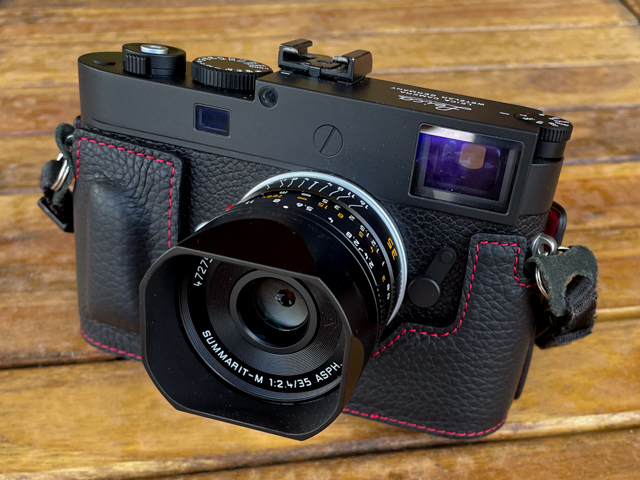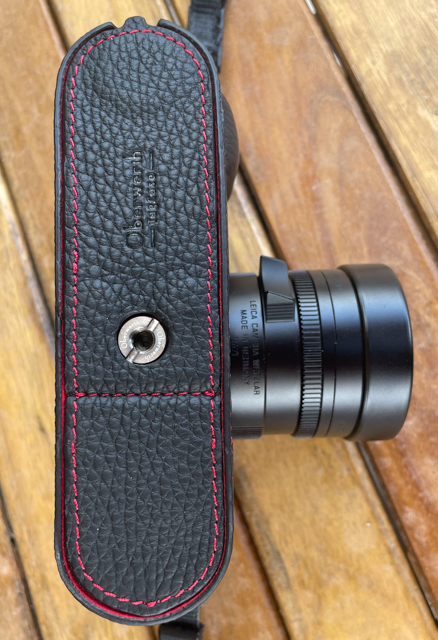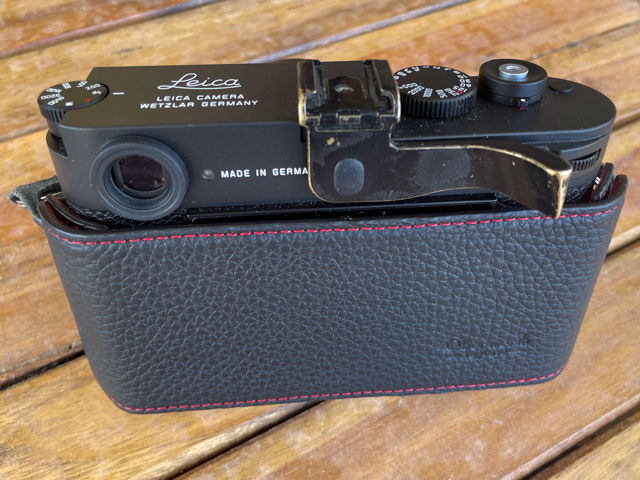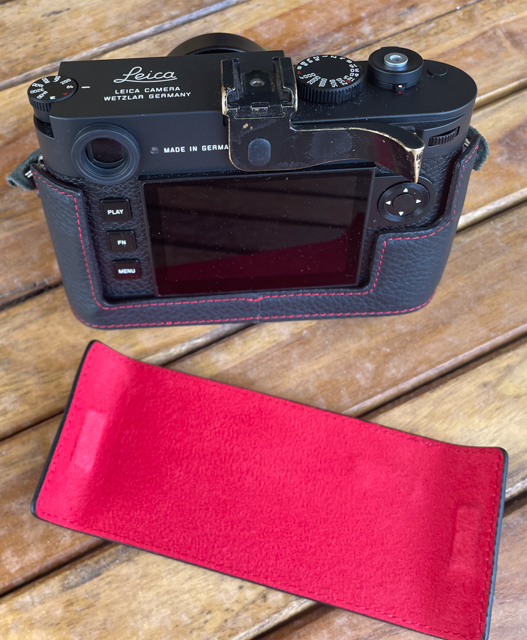Oberwerth Half-Case
writer: russell j.t. dyer; posted: Jul 2024; revised: Jul 2024
Recently, I puchased a Leica M11-P camera to go with my Leica 35mm lens. To handle better and to protect the camera from scratches and other damage, I bought an Oberwerth half-case you see in these photos. It cost a few hundred euros, which is a little pricey. However, considering how well it’s made and how much I paid for the camera it’s meant to keep safe, that’s not much to pay. Plus, it has some nice features that cheaper cases don’t have.
Before talking about the features, though, there’s the look and feel. The case is made of strong leather with red stiching. It looks very nice and it feels even better to hold. The camera is fairly heavy for its size, and I added a Match Tech. brass Thumbs Up for a firmer grip. But the textured leather case provides even better control. Plus, there’s a bump on the front of the case for my fingers to grip more securely.
As I said, it’s a little pricey but justifiable. Still, now that I’ve been using it for a few weeks, I’m surprised they don’t charge more for it.
Easy Access & Tracker
Leica M film cameras were made with a bottom plate that was removed to load film. When the Leica Camera company started making digital cameras, to keep cost to a minimum, they used the same bodies, with the removable plate. Instead of removing the bottom plate to remove and load film, it’s where the memory card and battery is accessed. It was a neat idea to use the same bottom plate, but it was irritating if I had the camera on a tripod, or if I had it in a case like this one.
Starting with Leica M11, including the Leica M11-P which I own, a new design was introduced that doesn’t have a removable bottom plate. You just push on the battery on the bottom of the camera to cause it to pop out. You push lightly again to release it and then remove it. Once the battery is out, I can access the memory card under where the battery’s brim was located.
The Oberwerth half-case is made with a small hinged door to expose the base of the camera’s battery for removing it and the memory card. This means that I don’t have to remove the case to change the battery or the memory card. So when my battery dies, I can quickly replace it with another. When I want to copy photos to my computer, I can easily remove the memory card to do so — I prefer this method rather than using the Leica Fotos application to transfer by bluetooth, or plugging into the bottom of the camera with a USB-C cable to copy images.
Besides the easy access port, there’s a small compartment at the bottom of the case made for inserting a bluetooth tracker, an Apple AirTag. I would add it before attaching the half-case with the tripod connector. As a result, unless someone knows it’s there, they won’t remove it and I can possibly find it with Apple’s tracking software — or at least I can see where it was last recorded when it was near me. I’m not sure I’ll be able to track down a thief who has my camera and isn’t close to me. Maybe that feature will be added later.
LCD Cover
As I mentioned in other articles, most recently in Using Hand Tools, I take better pictures when I don’t use the LCD. As I described in detail in the post Configuring the Leica M11-P, I used the LCD to configure the camera to my preferences and to disable many features meant to assist users — but not photographers. After saving all of my changes to a profile with my name, I put the Oberwerth case on, covering the LCD.
The result is that I can take photos without having to use the LCD: I just change the ISO sensitivity of the sensor and the lens aperture, focus, and press the shutter release button — all of which are controlled manually either on the top of the camera, or on the lens.
The main reason I don’t want to use the LCD is that it distracts from the creative process. Many times I’ve seen people taking a photo and looking immediately at the results in the LCD. They’re not satisfied with the results, so they take another one and another — never taking a good photo from what I can see. Rather than thinking about what they’re doing, concentrating on what they’re photographing and how their exposure settings will create an image, they’re fiddling with menus and reviewing the images they’ve taken. They’re jumping out of creative mode — maybe never really entering creative mode — and switching to some other hectic mode I might call garbage mode. Having a cover on the LCD and just thinking about taking pictures is great for me.
On the rare occasion, though, when I need to look at the LCD, to check some setting, I can remove the back cover easily. It’s attached with strong magnets that hold it well, but can be removed easily with this half-case. At this point, I might do this once every fifty or so photos. It’s becoming less and less as I get to know the camera better.



